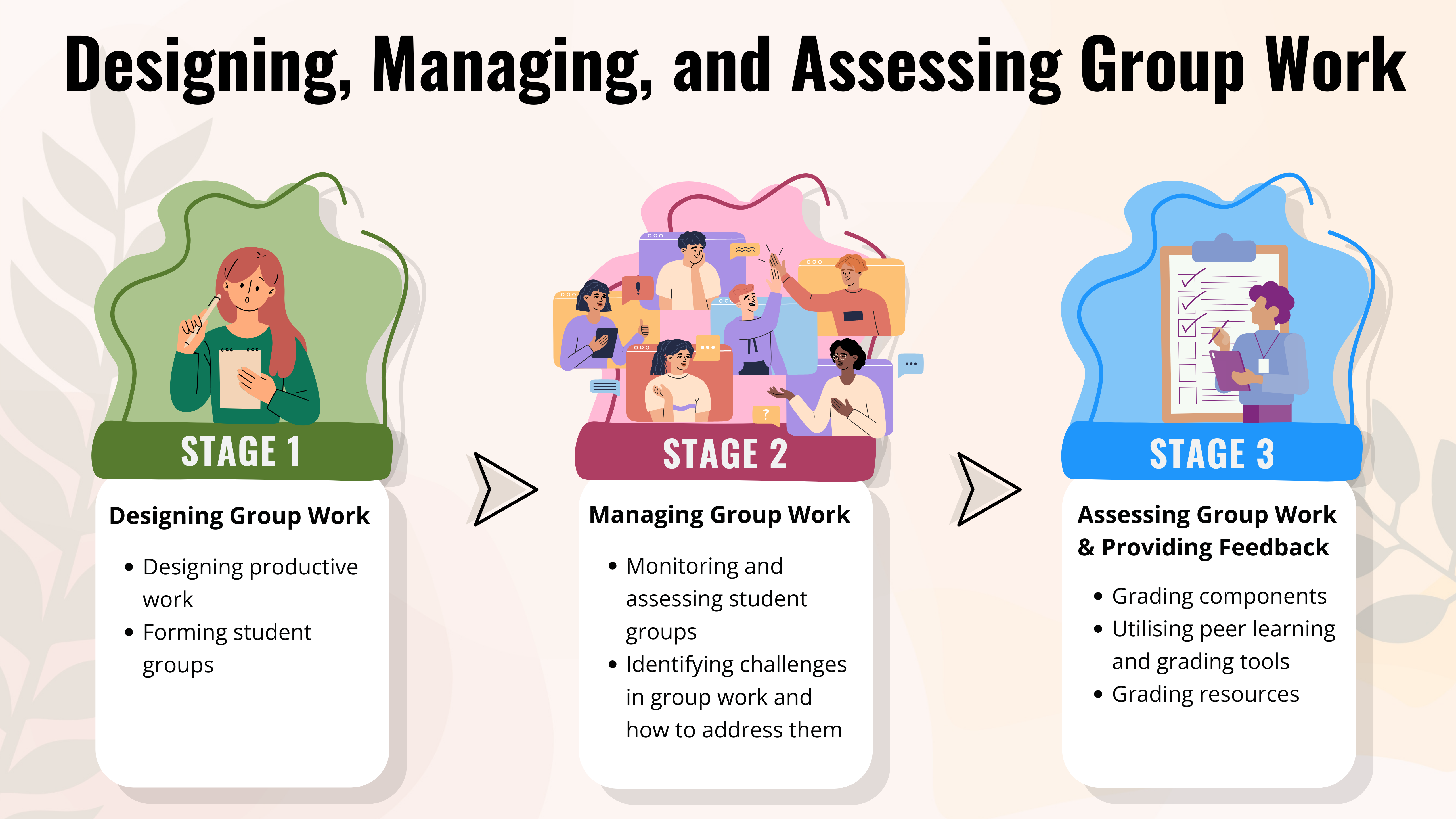
Group work is an essential component of SMU’s interactive pedagogy that implements peer learning through a collaborative strategy supported by social constructivism theories. In this approach, students engage in the learning process not only through direct instruction but also by actively interacting with their peers in both formal and informal settings. This pedagogical approach serves multiple purposes: it helps students prepare for the workforce by developing crucial communication and team building skills [13], while creating rich opportunities for peer learning where students share diverse perspectives and learn from one another’s experiences.
Additionally, group work facilitates valuable peer feedback opportunities, allowing students to develop critical evaluation skills while receiving diverse perspectives on their work from classmates. Through carefully designed group activities like classroom discussions and online forums, students move beyond passive reception of information to become active co-creators of knowledge. It is important for instructors to plan and design group work carefully, creating opportunities for meaningful peer exchanges while providing appropriate guidance throughout the group work process. This guide provides instructors with useful tips on designing and managing group work that maximises learning benefits, organised into 3 stages as shown in the graphic above.
Designing productive group work
Instructors must be aware of the considerations of designing group work to ensure a proper collaborative environment for students. Instructors must take the initiative to inform students of how to go about working in groups.[2]
Forming student groups
Instructors may allow students to form their own groups or to assign students into groups. The advantage of student self-formed groups is reducing time to get to know one another as students are already acquainted [1]. Some instructors may prefer allocating students to groups to ensure heterogeneity. Assignment of students can be done randomly[2], or based on certain considerations, such as learning outcomes, qualities of students such as their academic background, race, gender etc.[9]. This will help instructors to maintain the heterogeneity and form balanced groups.
Having only 2 students to a group may limit ideas and insights due to the lack of people being involved[7]. On the other hand, having a large group makes it difficult for every member to constantly contribute due to the lack of participation opportunities [2]. It is suggested assigning 4-5 students to the group as the most ideal group size [8]. On the other hand, having 3-4 students to the group might be more suitable [7]. Ultimately, it is up to the instructor to select an appropriate group size depending on the demands of the group work.
Designated group roles can be instructor-determined or established by students. Having group roles ensures smooth and effective group processes and help to reduce problems that may arise in a group setting e.g., uncooperative students, assertive students and misunderstanding of workload distribution among students [2]. Research has shown that assigning roles in group work have mitigated distraction, allowed more opportunities for student to participate, lesser occurrence of “social loafing” and propel students to learn more [10]. Here are some possible group roles designations [15][3]:
|
Group Role |
Description |
|---|---|
|
Facilitator |
Setting the agenda and objectives of group meetings, reiterating decisions and discussions made and ensure ground rules are adhered to. |
|
Note taker |
Keeping track of all the discussions and task delegations. |
|
Timekeeper |
Ensuring that the group spend the right amount of time on a particular task. |
|
Progress tracker |
Checking in with all the group members on their progress and sort any potential problems should the task needs more time to be worked on. |
|
Editor |
Compiling all the works together and ensure coherence and consistency in the overall group work. |
|
Presenter |
Collating the main points discussed in group meetings to present it to the class or instructors. |
|
Devil’s advocate |
Producing questions/opinions/views that differs with the group to promote thorough discussions/ debate. |
|
Priority Delegator |
Ensuring the group spend an appropriate amount of time for each task. |
|
Wildcard |
Standing in any missing role due to unavailability of other group members. |
Monitoring and assisting student groups
Here are some ways how instructors can assist groups in achieving their learning objectives:
Instruct students to log a weekly journal/ report denoting their progress or to present what they have done for the past week — individually or as a group[6]. Some online tools that instructors can consider include ELearn Journal, Padlet, Google Docs.
Additionally, the report can consist of information such as the group discussions’ main points, the group meetings’ attendance, and the plan for upcoming weeks [2]. This will help instructors to understand each member’s participation. Instructors can then provide constructive feedback to the group and/or individual team members.
Some examples of feedback are the progress of the group, what the group did well, what can the group improve [16]. Verbal feedback can be given through consultations or written feedback based on the group or the reflection journal/ peer evaluations that have been submitted.
Decide on a common mode of communication within students and with the instructor. Ensure students in the same group are aware of how to contact one another and to plan how they should work together [6]. They may utilize online communication tools such as SMU Timetable Bot (Telegram), Outlook Calendar, when2meet, Slack, Calendly to coordinate their schedules.
Instructors must inform students how they can reach their instructor should an issue occurs [6]. Instructors must also keep track of groups prematurely and reach out to students to ensure that it is not too late to solve the problems that the groups might be having [16].
Recommend website resources and provide links to class activities. Instructors may inform students of resources such as logs, websites, research journals, articles that might be useful for students to use and refer to for their group work [16].
For example, instructors may share with students the links to the Kahoot/ Wooclap quizzes that have been used in class activities. Instructors may also upload solution slides onto eLearn or make use of discussion forums e.g., eLearn, Piazza for students to clarify their doubts.
Instructors and students may also refer to the Teaching Learning Survival Tools: User Guides & FAQs for more information.
Identifying challenges in group work and how to address them
Here are some usual challenges that students might face when working together for a group work and the strategies that may help to mitigate the issues[4][11][12]:
|
Common Challenges |
Strategies |
|---|---|
|
Additional time and effort that a group work needs e.g., synchronise schedules, making consensus as a group, or compiling of individual tasks together. |
|
| Free riders who are not motivated to do any of the tasks. |
|
|
Conflicts among group members which can cause lack of participation among group members. |
|
|
Students may tend to agree with one another to avoid conflict (Groupthink). |
|
Grading components
Brief students on assessment criteria and grading scheme
Be clear in communicating the assessment criteria to ensure student are aware of the standard they are expected to meet [5]. This is also to avoid a frequent issue in group work where frustrations happened among students due to the misconception of how they are being graded [14].
Evaluating group processes
Instructors can consider using reflection reports to gain a better understanding of the processes (e.g., producing ideas, delegating tasks impartially, being respectful with one another etc.) to grade them [5]. Students can be both evaluated as a group and individually. Some examples include team evaluations where each student will appraise the overall collaboration of the team, peer evaluations where each student will appraise each other’s quality of work and self-evaluations where each student will reflect on his or her contributions towards the group work.
Utilising Peer Learning and Grading Tools
Instructors can enhance group assignments or projects through two tools available on eLearn: the Peer and Self Feedback System (PSFS) and the Peer Evaluation Tool (PET). These tools let students evaluate their own and their peers’ group contribution. This process not only creates a monitoring and feedback mechanism for group contribution but also helps students identify areas for improvement (e.g. come to meetings on time), fostering a culture of self-reflection and growth. Instructors have flexibility in how they incorporate these evaluations into their grading structure. They may choose to assign a specific weighting of the module grade to peer and self-evaluations (see Teaching Handbook p. 44 for assessment component guidelines). They can also use students’ self and peer feedback reports to inform their grading of students’ group work, allowing for a more comprehensive assessment of individual contributions and teamwork.
I. Peer and Self Feedback System (PSFS)
The PSFS is a student-centred and user-friendly system that facilitates the collation of peer feedback for courses with group projects. It features standardised yes/no descriptors that allow students to assess both their own contributions and those of their peers. This enables self-reflection while fostering the evaluation of teammates’ performance. The PSFS enables peers to provide constructive feedback on the SMU Graduate Learning Outcomes of Collaboration and Leadership across three categories: (1) Responsibility and commitment, (2) Contribution to team effectiveness, and (3) Contribution towards team deliverables (quality and quantity of work).
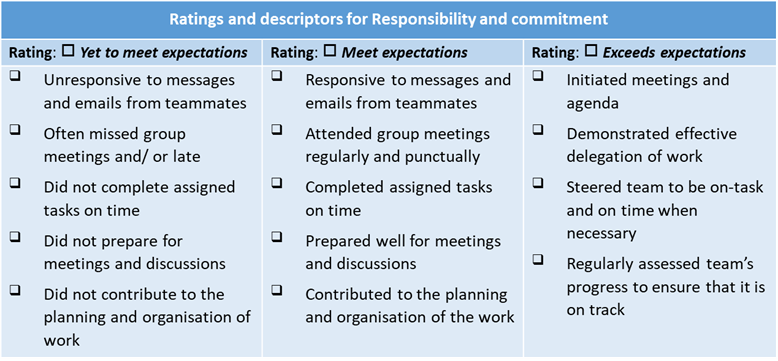
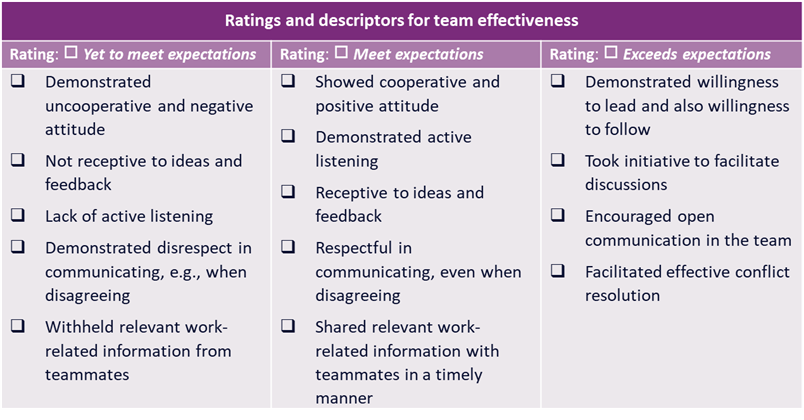
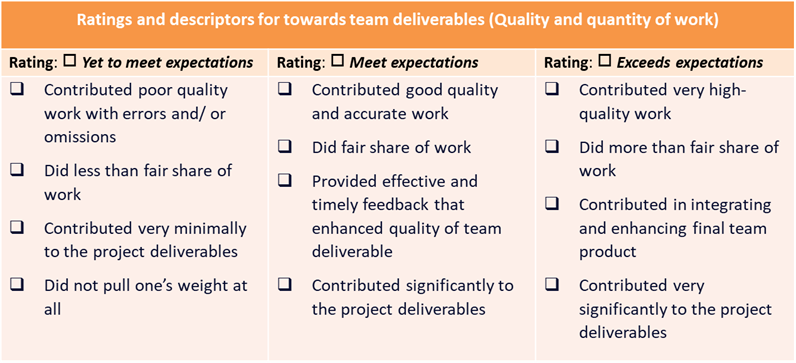
Note: The specific descriptors students can check off depend on the selected rating in the top row. For example, if they rate their peers as 'meet expectations', they will select the descriptors in that column only.
This system is easy to navigate and use for students and instructors and, because it uses a standard measurement across courses, will provide valuable insights into learners' development over time, both for the learner and for the University. For instructors, please visit the PSFS User Guide for detailed screenshots and instructions on accessing PSFS.
Upon entering the system, students will be presented with instructions on how to proceed with their evaluation.
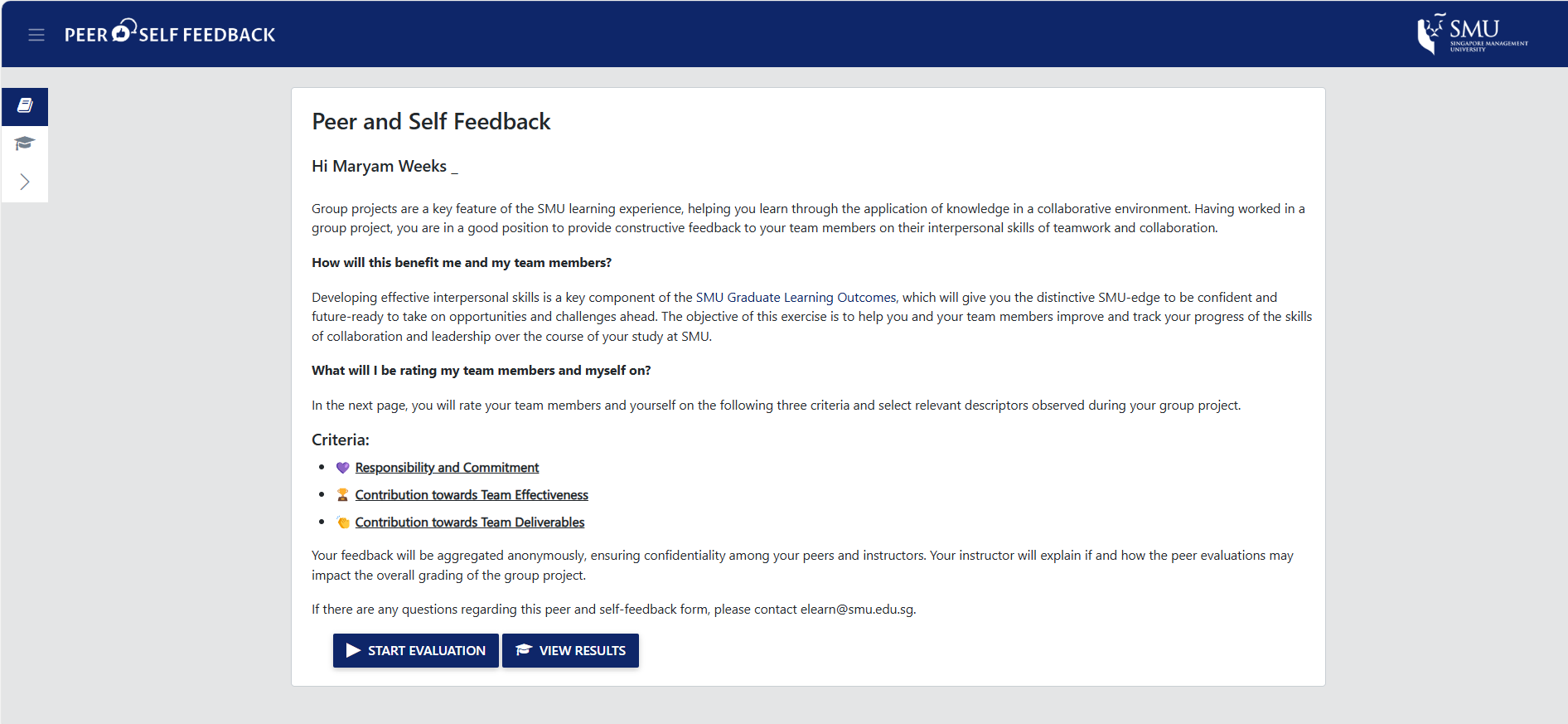
During the evaluation process, they will be presented with a number of questions (Refer to the diagram above) and be tasked to evaluate based on these criteria.
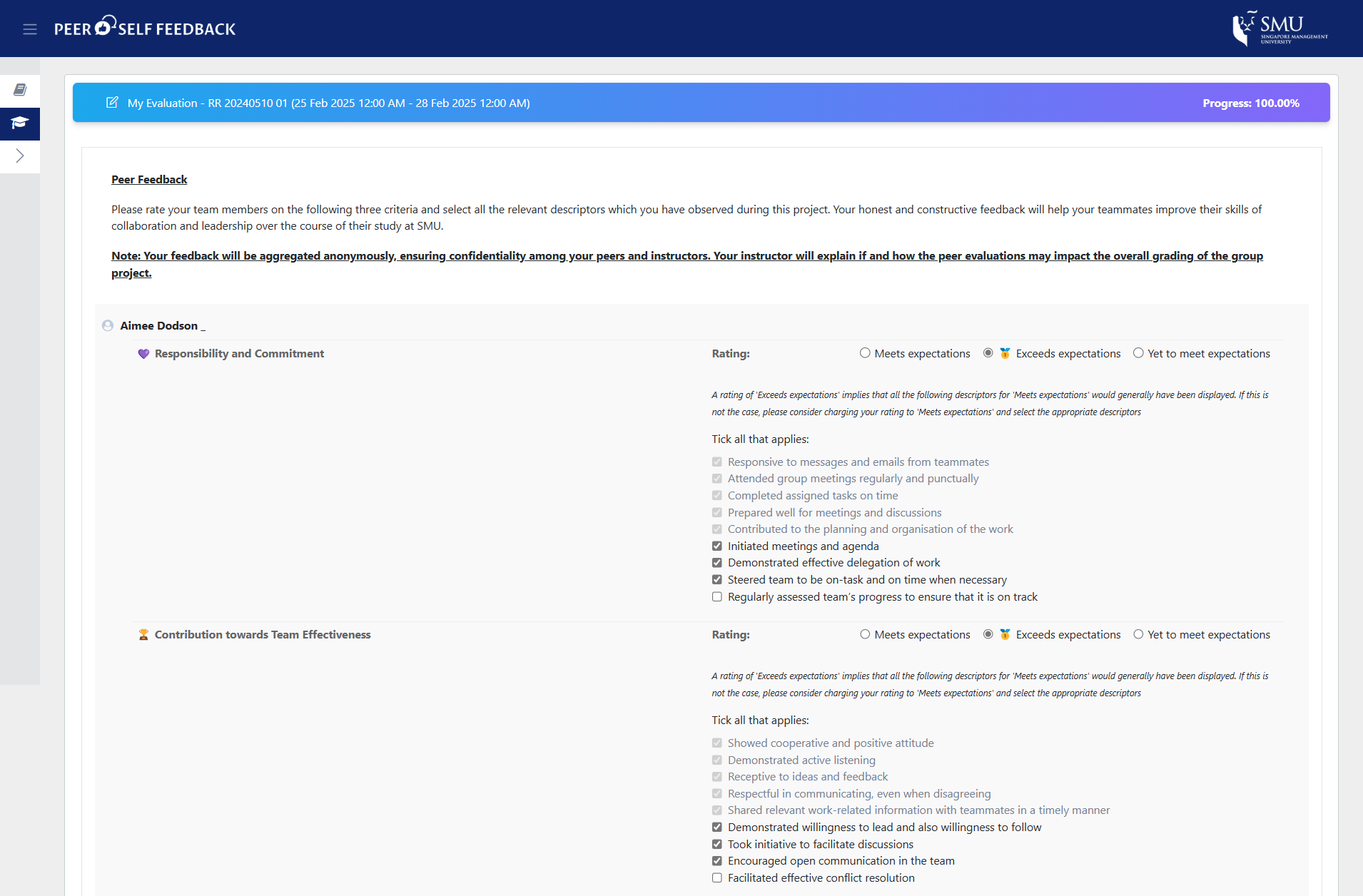
Once the evaluation is complete, students will be able to see the results of their group's evaluation.
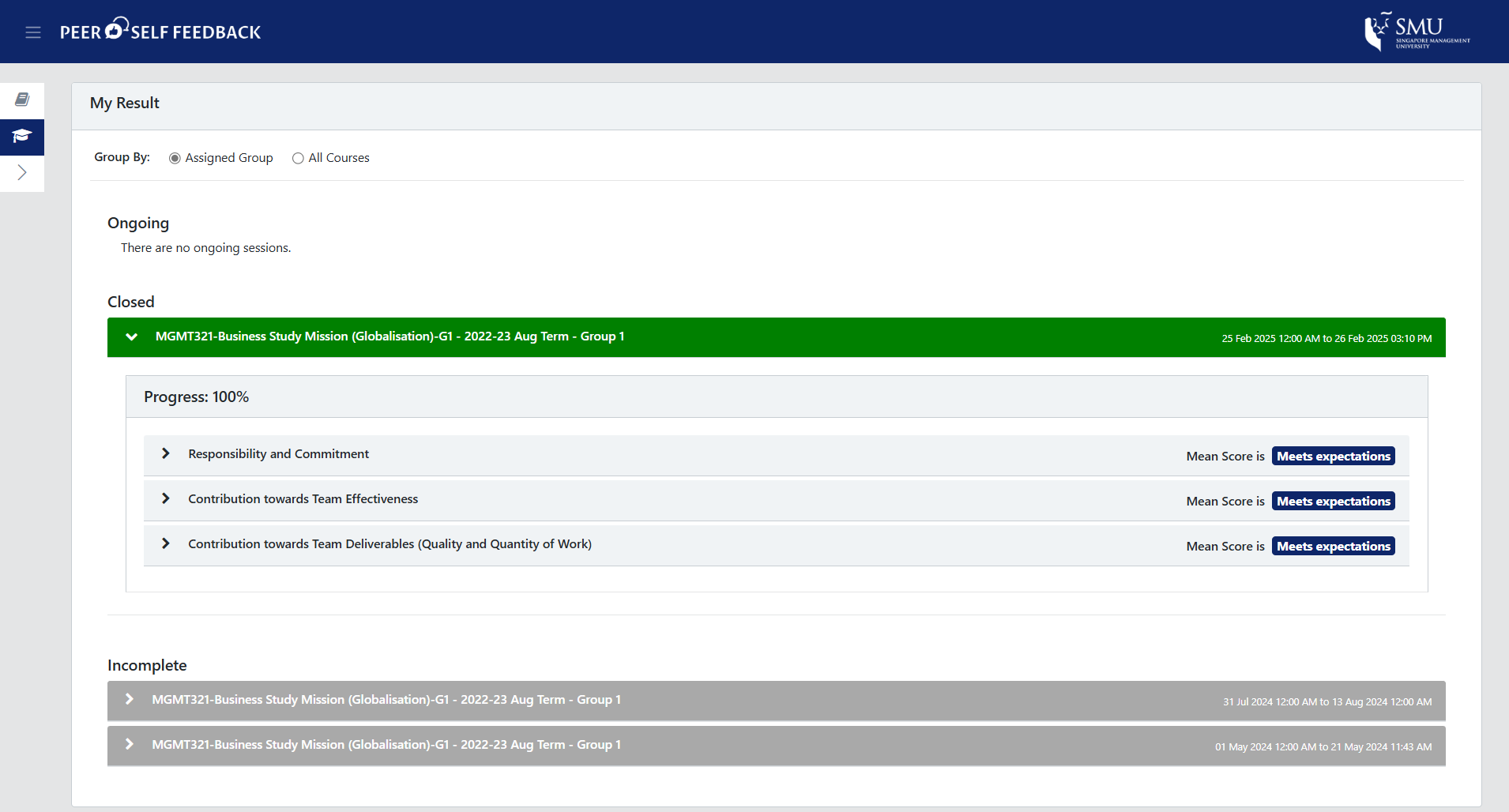
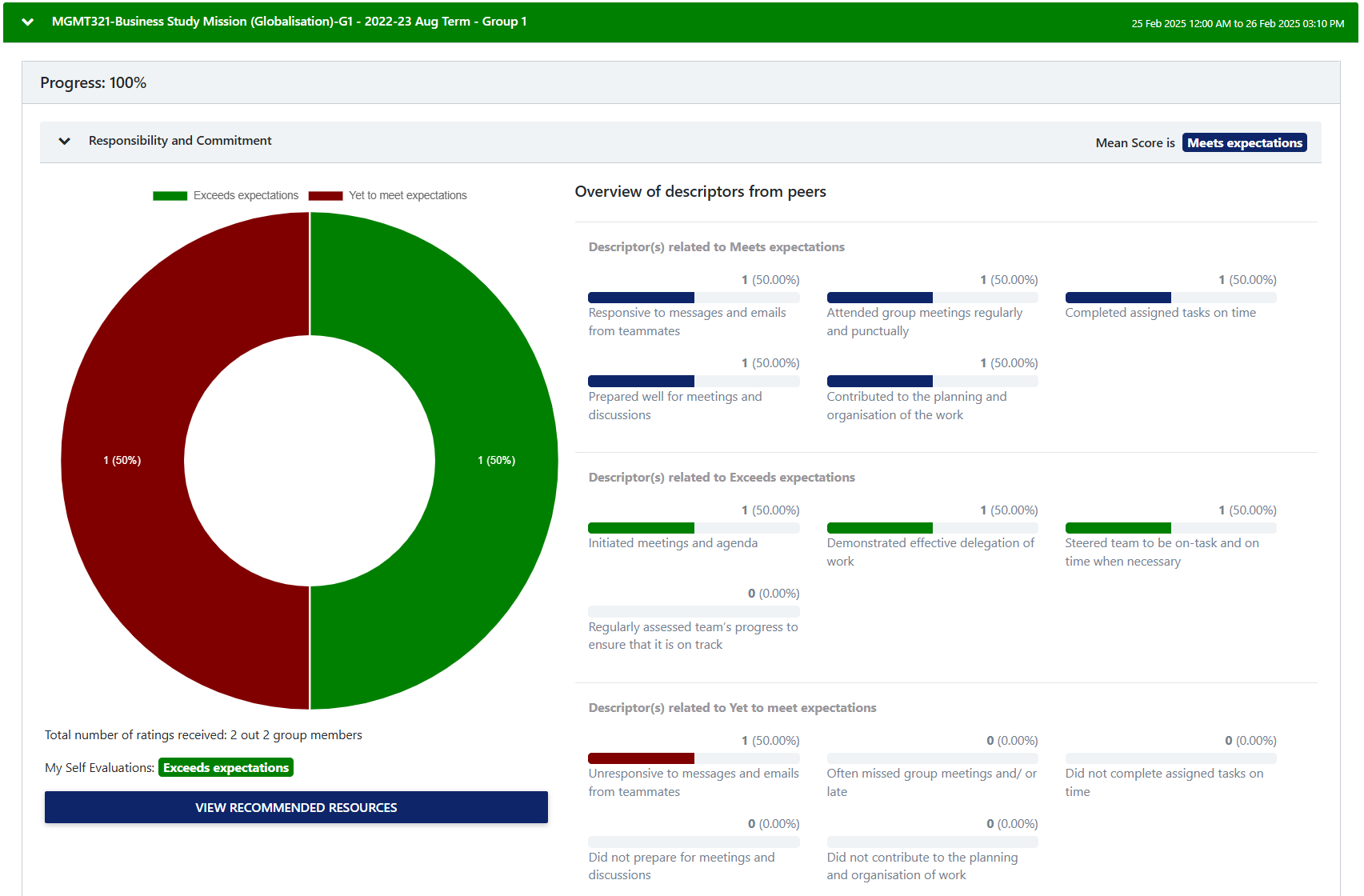
II. Peer Evaluation Tool (PET)
For instructors who prefer more flexibility, PET offers a customisable alternative. This tool allows instructors to create tailored evaluation questions that align with specific course objectives and assessment criteria. Students can respond to these questions, with both quantitative ratings and qualitative comments, as set by the instructor, assessing both their own performance and that of their peers. This provides an opportunity for deeper self-reflection and encourages more comprehensive feedback on individual contributions within the group. Instructors can refer to the survey items in the CATME Tool when designing their own custom questions for the peer evaluation tool. For more information, please visit the PET User Guide for detailed screenshots and instructions on accessing PET.
PSFS vs PET Comparison Table
| PSFS | PET | |
|---|---|---|
| Evaluation Questions |
|
|
| Customisation |
|
|
| Setup and configuration |
User Guide: PSFS
|
User Guide: PET
|
| Instructor View |
|
|
| Student input |
|
|
| Student view |
|
|
Grading resources
Instructors are encouraged to adhere to the University’s grading guidelines in designing the grading scheme for group work. More information can be found in the Teaching@SMU Handbook (SMU login required).
Here are some resources (e.g., grading Class Participation, Assignment, Presentation, Project, Peer Evaluation) that instructors may use for assessments:
|
Group Evaluation |
Individual Evaluation |
|---|---|
|
|
Bibliography
- Bacon. D. R., Stewart, K.A., & Silver, W.S. (1999). Lessons from the best and worst student team experiences: How a teacher can make the difference. Journal of Management Education, 23(5), 4670488. doi: 10.1177/105256299912300503
- Burke, A. (2011). Group Work: How to Use Groups Effectively. The Journal of Effective Teaching, 11(2), 87-95. https://uncw.edu/jet/articles/vol11_2/burke.pdf
- California State University San Marcos (n.d.). Group Work and Roles. https://www.csusm.edu/iits/services/ats/idesign/cougarcourses/guides/groups-best-practices/index.html
- Carnegie Mellon University (n.d. a) What are the challenges of group work and how can I address them? https://www.cmu.edu/teaching/designteach/design/instructionalstrategies/groupprojects/challenges.html
- Carnegie Mellon University (n.d. b) How can I assess group work? https://www.cmu.edu/teaching/designteach/design/instructionalstrategies/groupprojects/assess.html
- Carnegie Mellon University (n.d. c) How can I monitor groups? https://www.cmu.edu/teaching/designteach/design/instructionalstrategies/groupprojects/monitor.html
- Csernica, J., Hanyka, M., Hyde, D., Shooter, S., Toole, M., & Vigeant, M. (2002). Practical guide to teamwork, version 1.1. College of Engineering, Bucknell University
- Davis, B. G. (1993). Tools for Teaching. Jossey-Bass Inc., San Francisco: California.
- Connery, B. A. (1988) Group Work and Collaborative Writing. Teaching at Davis, 14(1), p. 2-4. (Publication of the Teaching Resources Center, University of California at Davis)
- De Meyst, K., Grenier, J. (2021). Assigning Roles to Increase the Effectiveness of Group Work https://www.scholarlyteacher.com/post/assigning-roles-to-increase-the-effectiveness-of-group-work
- Iowa State University (n.d.) Common Group Work Challenges and Solutions https://www.celt.iastate.edu/teaching/effective-teaching-practices/group-work/common-group-work-challenges-and-solutions/
- The University of Queensland (n.d.) Resolving group work issues https://my.uq.edu.au/information-and-services/student-support/study-skills/group-work/resolving-group-work-issues#0
- University of Birmingham. (n.d.) Why work in Groups? https://birmingham.ac.uk/schools/metallurgy-materials/about/cases/group-work/why.aspx
- University of Greenwich (n.d.) Assessing Group Work https://www.gre.ac.uk/learning-teaching/assessment/assessment/practice/assessing-group-work
- UNSW Sydney (n.d. a). Guide to Group Work. https://www.student.unsw.edu.au/groupwork
- UNSW Sydney (n.d. b). Facilitating and Monitoring Group Work. https://www.teaching.unsw.edu.au/facilitating-and-monitoring-group-work
- University of Waterloo (n.d.) Implementing Group Work in the Classroom https://uwaterloo.ca/centre-for-teaching-excellence/teaching-resources/teaching-tips/alternatives-lecturing/group-work/implementing-group-work-classroom
- University of Massachusetts Amherst (n.d.) How Do I Design Successful Group Work and Collaborative Assignments https://www.umass.edu/ctl/resources/how-do-i/how-do-i-design-successful-group-work-and-collaborative-assignments